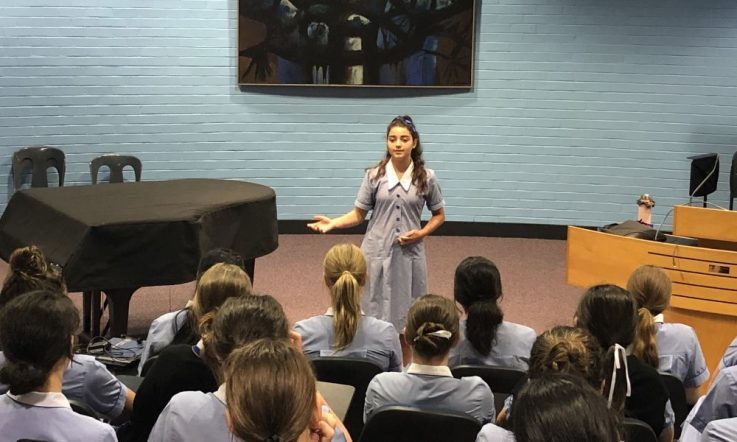After noticing their secondary English students were stressed by oral presentations (and coming up with ways to avoid them all together), Dr Sunaina Sharma and Wendy Lang wanted to find out more. In this reader submission, the Ontario educators discuss how student voice led them to adjust their teaching, based on a trauma-informed approach, while still meeting curriculum requirements. In a follow-up article tomorrow, they’ll share 4 strategies they’ve implemented to build the same speaking and listening skills while reducing the stress level for students.
In today's educational landscape, fostering strong oral communication skills in school students is imperative, as it is a skill highly sought after by employers (Rios et al., 2020). Oral communication is not merely a component of the curriculum; it is a fundamental skill essential for success in both academic and professional realms.
The ability to articulate thoughts coherently, engage in meaningful dialogue, and present ideas with confidence is indispensable in navigating the complexities of the modern world. Oral communication is cross-curricular, but is clearly mandated in the English classroom.
As secondary English teachers, our responsibility is to empower students in enhancing their reading, writing, oral communication, and media skills – 4 essential strands outlined in the province-mandated curriculum here in Ontario, Canada. However, the escalating prevalence of anxiety and mental health challenges among our students has rendered oral presentations particularly daunting for them.
Because oral communication accounts for one-quarter of the English curriculum, tasks requiring students to present were embedded into every single unit. Typically, this involved students preparing a presentation and then delivering it in front of the entire class. Sometimes it was a formal speech, other times a persuasive pitch, or even a demonstration on how to do something.
Regardless of the format, students were expected to stand in front of their peers and speak. Given that presentations were an integral part of each unit, a student would complete approximately 3 to 5 presentations each semester.
In 2019, we began to notice avoidance and refusals among our grade 9 to 12 students, with many requesting to present ‘just in front of the teacher.’ Although this behaviour was evident across all grades, it was more pronounced in grade 11 and 12 students. Perhaps the added pressure of excelling on evaluated tasks to meet their post-secondary goals exacerbated their anxiety. This created a debilitating need to perform perfectly, leading many to shy away from presenting in front of the class. For those who did attempt it, visible signs of stress – such as trembling, tears, nausea, flushed faces, and perspiration – were all too common.
This anxiety around presentations was amplified following the return to in-person learning after the emergency remote teaching period during COVID-19. In 2021, as students transitioned back to brick-and-mortar classrooms, the challenges of oral presentations became even more pronounced. The extended period of isolation and lack of face-to-face interactions during remote learning seemed to intensify the stress students felt when asked to present in front of their peers.
Witnessing these distressing reactions prompted us to consider a trauma-informed approach. This approach enabled us to partner with students, helping us understand the care and support they needed to feel more comfortable presenting.
We aimed to be mindful of the potential trauma presentations could cause, fostering safe and trusting relationships with students. By creating opportunities for choice, collaboration, and connection, we allowed students to build on their strengths (Alvarez-Ortiz et al., 2020).
Engaging with the curriculum and student voice
We began by revisiting our curriculum documents to gain a comprehensive understanding of the standards students were expected to achieve. Recognising the importance of aligning any modifications to traditional oral communication tasks with curriculum expectations, we ensured that our adjustments would still uphold the prescribed learning outcomes.
We noted that students needed to ‘use speaking skills and strategies appropriately to communicate with different audiences for a variety of purposes’ and ‘listen in order to understand and respond appropriately in a variety of situations for a variety of purposes,’ (Ontario Ministry of Education, 2007, p. 42).
Then we both electronically surveyed and talked to our students. This dialogue would allow us to ‘co-design educational situations and learn together,’ (Edes, 2020, p. 85). Although we leaned in to listen to those students who showed visible signs of stress, we also ensured all our other students were heard too. This allowed us to take on the role of an empathetic facilitator (Brown, 2007).
This was important, because we recognised that although students might not show visible signs of stress, it doesn't mean they don’t feel stress. In fact, we heard from our students that they would skip class or stay home under the guise of being sick to avoid oral presentations.
Our conversations with students revealed that they were extremely articulate and capable of communicating their ideas to us but, also, they were able to listen to our perspectives and respond appropriately. These conversations allowed our students to share their feelings and concerns, whilst allowing us to share our voices as English teachers and our need to be able to evaluate students’ ability to meet all the curriculum expectations as a professional responsibility.
These conversations fostered what Dörnyei and Murphey (2004) term ‘intermember relationships’ in learning about each other as much as possible through sharing genuine personal information.
Building oral communication skills and reducing anxiety
Interacting individually with students, conducting small group discussions, providing quick short surveys, and engaging in whole-class dialogues unveiled crucial insights. Students acknowledged the importance of oral communication tasks, expressing a genuine desire to articulate their thoughts.
Despite their preparation for presentations, the prospect of facing their peers caused significant anxiety. Consistently, they cited the daunting feeling of being scrutinised by 30-plus pairs of eyes and of standing alone at the front of the room.
Drawing from their feedback, we adjusted our approach to assessing their oral communication skills.
Stay tuned: In tomorrow’s article, Dr Sunaina Sharma and Wendy Lang share 4 strategies they’ve implemented to build the same speaking and listening skills while reducing the stress level for students.
References
Alvarez-Ortiz, L., Haynes, J., & Zacarian, D. (2020). Meeting student trauma with an asset-based approach. Association for Supervision and Curriculum Development.
Brown, H. D. (2007). Teaching by principles: An interactive approach to language pedagogy (3rd ed.). Pearson Education.
Dörnyei, Z. & Murphey, T. (2004). Group dynamics in the language classroom. Cambridge University Press.
Edes, I. (2020). Listening to student voice. Taboo: The Journal of Culture and Education, 19(2), 81–91.
Ontario Ministry of Education. (2007). The Ontario Curriculum Grades 11 and 12: English. Revised. https://www.edu.gov.on.ca/eng/curriculum/secondary/english1112currb.pdf#page=42
Rios, J. A., Ling, G., Pugh, R., Becker, D., & Bacall, A. (2020). Identifying critical 21st-century skills for workplace success: A content analysis of job advertisements. Educational Researcher, 49(2), 80-89. https://doi.org/10.3102/0013189X19890600
In this article, Dr Sunaina Sharma and Wendy Lang explain how they used student voice to adapt their teaching approach.
How often do you gather feedback from your own students? What methods do you use to ensure students feel comfortable in sharing? How do their responses inform your approach to teaching and learning?



